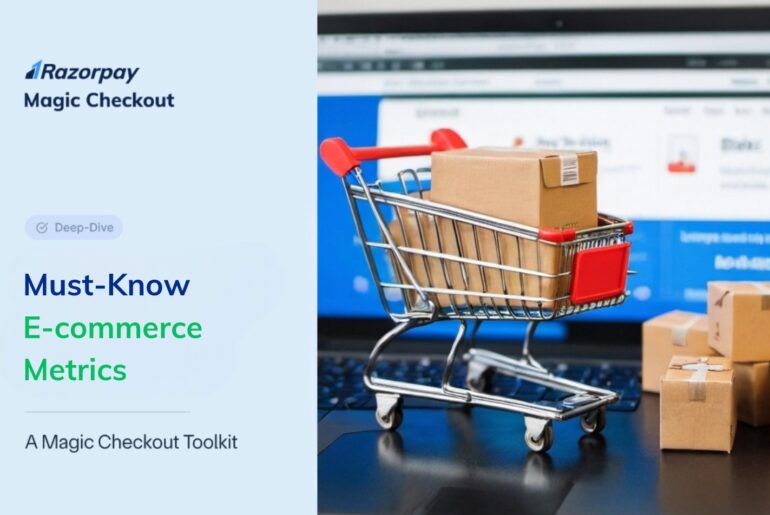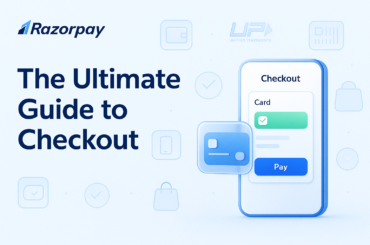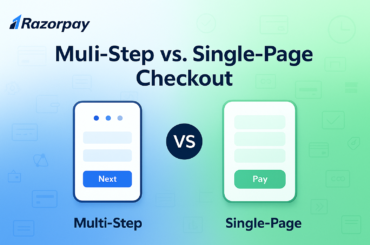Metrics have been a part of our lives since childhood. Think back to those report cards we received in school—tools that measured our performance. In the world of business, things aren’t much different. Today, however, we don’t call them report cards; instead, we use e-commerce metrics to track and evaluate business performance.
Every business aims to understand the key e-commerce metrics they should be paying attention to. With countless metrics available, it’s essential to identify which ones truly matter. For established businesses, this blog can serve as a helpful refresher to ensure you’re tracking all the critical metrics. And if you’re just starting out, this is your go-to resource to make sure you’re on the right path from day one. Without further ado, let’s dive into the essential e-commerce metrics every business should monitor.
Table of Contents
What Are E-commerce Metrics?
E-commerce metrics are vital data points that allow businesses to measure their performance across various areas. These metrics help track crucial factors like website traffic, cart abandonment rate, conversion rate, customer acquisition cost, and net profit margin. By analyzing these numbers, businesses can make informed decisions that drive sales and growth.
E-commerce Metrics vs. KPIs: What’s the Difference?
Though metrics and KPIs (Key Performance Indicators) are often used interchangeably, they serve different purposes:
Purpose:
E-commerce metrics track a wide range of business activities, like website traffic or sales volume, offering insights into what’s happening in different areas.
KPIs focus on specific, high-priority goals, such as how many visitors convert into paying customers.
Importance:
Metrics provide a general overview, but not all of them are critical for success.
KPIs, on the other hand, are the top-priority numbers that indicate whether your business is on track.
Actionable Insights:
Metrics give valuable information but don’t always suggest what steps to take.
KPIs, however, are more targeted, often guiding specific actions to improve performance.
In short, metrics offer a broad view, while KPIs zero in on the most important numbers that reveal whether you’re meeting your goals.
When Should You Track Your E-commerce Metrics?
The frequency of tracking metrics depends on the type of data you’re analyzing. Some metrics require daily attention, while others can be reviewed weekly, monthly, or quarterly.
- Daily Tracking: Metrics tied to sales, like conversion rates and cart abandonment rates, should be monitored daily. The same goes for your website traffic to keep a pulse on real-time trends.
- Weekly Tracking: For performance metrics related to advertising, email open rates, or calls-to-action (CTAs), a weekly check is ideal. This allows for regular adjustments to optimize results.
- Monthly Tracking: Long-term metrics like customer acquisition cost (CAC) and return on ad spend (ROAS) are better suited for monthly reviews. Comparing monthly reports will help you fine-tune your strategies.
- Quarterly Tracking: Metrics that take longer to reflect change, such as profit margins, growth rate, and business scalability, should be evaluated quarterly. This timeframe provides a clearer picture of long-term trends and gives you the opportunity to make strategic decisions for sustained growth.
Now let’s explore the specific e-commerce metrics every business should track to ensure success.
Acquisition and Traffic

- Customer Acquisition Cost (CAC):
What It Is: CAC measures the total cost of acquiring a new customer, including marketing and sales expenses.
Why It Matters: This e-commerce metric is crucial for understanding the efficiency of your marketing efforts. Keeping CAC lower than your Customer Lifetime Value (CLV) is essential to maintaining profitability.
Formula: CAC = Total Cost of Acquisition / Number of Customers Acquired
- Organic vs. Paid Traffic:
What It Is: Organic traffic, a key factor in e-commerce metrics, comes from search engines without paid advertising, while paid traffic is driven by ad campaigns.
Why It Matters: A balance between organic and paid traffic ensures sustainable growth. Paid traffic provides quick wins, but organic traffic is more cost-effective in the long run.
Note: Google Analytics provides both organic and paid traffic data under the “Acquisition” section, which breaks down the traffic sources.
- Cost-per-Click (CPC):
What It Is: CPC measures the amount paid for each click on an ad in your paid advertising campaigns.
Why It Matters: Monitoring CPC helps you optimize ad spend and ensure cost-efficiency. To reduce CPC and lower customer acquisition costs, focus on improving page quality score, refining targeting, optimizing bids based on performance and competition, and testing ad variations.
Formula: CPC = Total Ad Spend / Total Clicks
- Return on Ad Spend (ROAS):
What It Is: ROAS, one of the crucial e-commerce metrics, calculates the revenue generated from each dollar spent on advertising.
Why It Matters: A high ROAS indicates a successful and profitable advertising campaign. It helps D2C brands allocate budgets effectively.
Formula: ROAS = Revenue Generated / Advertising Cost
- Click-through Rate (CTR):
What It Is: CTR measures the percentage of people who click on an ad after seeing it.
Why It Matters: A high CTR means your ads resonate with your target audience. To drive even more traffic and conversions, optimize your CTR by refining audience targeting, crafting engaging copy, testing variations, and using relevant keywords.
Formula: CTR = (Clicks / Impressions) * 100
Website and Business Performance
- Bounce Rate:
What It Is: Bounce rate, an essential indicator in e-commerce metrics, represents the percentage of visitors who leave your website after viewing only one page.
Why It Matters: A high bounce rate can signal a poor user experience, irrelevant content, or slow page load times. To reduce your bounce rate and boost engagement and conversions, focus on improving page load speed, enhancing content relevance, optimizing user experience, and using engaging visuals.
Formula: Bounce Rate = (Number of Single-Page Visits / Total Visits) * 100
- Average Session Duration:
What It Is: This metric measures the average time visitors spend on your website during a session.
Why It Matters: A longer session duration indicates that visitors find your content engaging and valuable. Increasing this e-commerce metric can lead to higher conversion rates.
Note: Please visit Google Analytics to check your average session duration for accurate data.
- Conversion Rate:
What It Is: Conversion rate is the percentage of visitors who complete a desired action, such as making a purchase or signing up for a newsletter.
Why It Matters: Higher conversion rates, a key focus in e-commerce metrics, mean more visitors are turning into customers. Optimizing your website and checkout process can significantly boost this metric.
Formula: Conversion Rate = (Number of Conversions / Total Visitors) * 100
- Cart Abandonment Rate:
What It Is: This metric measures the percentage of shoppers who add items to their cart but leave without completing the purchase.
Why It Matters: Reducing cart abandonment can directly impact sales. Offering incentives like free shipping or streamlined checkout processes can help retain potential customers.
Formula: Cart Abandonment Rate = (Number of Abandoned Carts / Number of Carts Created) * 100
Note: Cart abandonment is a crucial e-commerce metric for e-commerce and D2C businesses. To keep this rate low, it’s essential to minimize friction in the checkout process. Even minor obstacles can lead to customer drop-offs and impact your conversion rate. This is where tools like Magic Checkout come in, streamlining the experience by automatically prefilling customer information—such as contact, shipping, and payment details—for a smoother, faster checkout process. Brands like Fae Beauty, Metalkart, and Indulgeo Essentials have seen enhanced conversion rates and a more seamless checkout experience with Magic Checkout.
- Return to Origin (RTO) Rate:
What It Is: RTO measures the percentage of orders that are returned to the origin, usually due to delivery failures or customer returns.
Why It Matters: A high RTO rate can erode profits. Reducing RTO by improving logistics, customer communication, and product descriptions can protect your margins.
Formula: RTO Rate = (Number of Returned Orders / Total Number of Orders) * 100
Note: Return to Origin (RTO) can significantly impact profits, making it crucial to address it effectively. A robust RTO intelligence tool can help by identifying risky orders through advanced algorithms, disabling COD on high-risk transactions, and offering actionable insights to enhance logistics and customer communication. Click here to discover more about how Razorpay Magic’s RTO intelligence can make a difference.
Financial Health

- Cost of Goods Sold (COGS):
What It Is: COGS represents the direct costs incurred in producing the goods you sell.
Why It Matters: Monitoring COGS helps D2C brands understand profit margins. To optimize COGS and achieve higher profitability without raising prices, focus on improving supplier negotiations, streamlining production processes, and reducing waste.
Formula: COGS = Beginning Inventory + Purchases – Ending Inventory
- Net Profit Margin:
What It Is: Net profit margin shows the percentage of revenue that remains as profit after all expenses are deducted.
Why It Matters: A healthy profit margin is key to sustainable growth. Monitoring this e-commerce metric helps identify cost-saving opportunities and adjust pricing strategies.
Formula: Net Profit Margin = (Revenue – Costs) / Revenue * 100
- Average Order Value (AOV):
What It Is: AOV calculates the average amount a customer spends per order.
Why It Matters: Increasing AOV can significantly boost revenue without the need to acquire new customers. D2C brands can enhance AOV by implementing strategies such as offering product bundles, upselling, or cross-selling. These tactics encourage customers to spend more per transaction, leading to higher overall sales and improved profitability.
Formula: AOV = Total Revenue / Number of Orders
Customer Metrics
- Customer Retention Rate (CRR):
What It Is: CRR measures the percentage of customers who make repeat purchases over a specific period.
Why It Matters: Retaining existing customers is often more cost-effective than acquiring new ones. A high retention rate reflects customer satisfaction and loyalty. To improve retention, focus on enhancing customer service, personalizing communication, implementing loyalty programs, soliciting feedback, and creating valuable content.
Formula: CRR = (Number of Customers at End of Period – Number of New Customers Acquired) / Number of Customers at Beginning of Period * 100
- Customer Lifetime Value (CLV):
What It Is: CLV estimates the total revenue a customer will generate throughout their relationship with your brand.
Why It Matters: Maximizing CLV through customer loyalty programs and retention strategies can significantly improve profitability over time.
Formula: CLV = Average Order Value * Purchase Frequency * Customer Lifespan
- Customer Satisfaction Score (CSAT):
What It Is: CSAT measures customer satisfaction through surveys, typically asking customers to rate their experience on a scale.
Why It Matters: A high CSAT score shows that customers are happy with your products and services, which can lead to repeat business and positive word-of-mouth.
- Net Promoter Score (NPS):
What It Is: NPS measures customer loyalty by asking customers how likely they are to recommend your business on a scale of 0 to 10.
Why It Matters: A high NPS indicates strong customer loyalty and advocacy, which can drive organic growth through referrals.
- Churn Rate:
What It Is: The churn rate measures the percentage of customers who stop doing business with you over a specific period.
Why It Matters: Reducing churn is critical for maintaining a stable customer base, and understanding why customers leave can help improve retention strategies. To optimize churn rate, focus on enhancing customer support, analyzing feedback to address pain points, personalizing interactions to meet customer needs, implementing proactive retention strategies, and offering incentives to stay.
Formula: Churn Rate = (Number of Customers Lost / Total Number of Customers at the Beginning of the Period) * 100.
Wrapping Up: Key E-Commerce Metrics for Enhanced Performance
Mastering these e-commerce metrics is essential for optimizing your store’s performance and driving growth. By tracking and improving these key indicators, you can reduce cart abandonment, minimize RTO rates, and enhance profitability. Ready to take it a step further? Try Magic Checkout to streamline your checkout process and watch your conversions soar.




